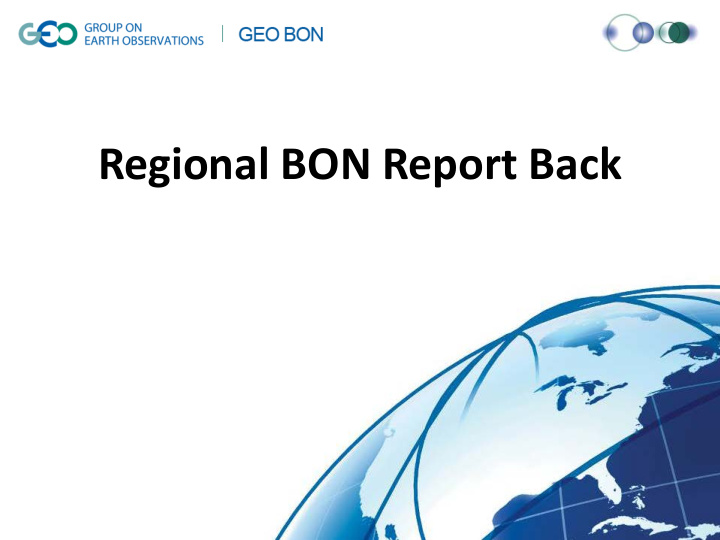



Regional BON Report Back
RBON’s: Existing and Potential • Existing: – Asia-Pacific – EU-BON – Arctic-BON (CBMP) – ASEAN Centre for Biodiversity – Others (e.g. Antarctic BON) • Potential: – Neotropical BON – US BON (Marine & Terrestrial) – Southern Africa BON
Implementation Global Global perspective perspective WGs WGs & partners & partners Define Deliverables Delivery (2015) Conceptualize Implement Coordination Coordination RBONs RBONs & partners & partners Regional Regional perspective perspective Page 3
Interaction between the RBON’s • Sharing experience, tools: – Network organization – Linking to National and International reporting mandates (e.g. CBD, MEA, RAMSAR, Env Assessment, etc.) – Data management and reporting tools – Data entry smart filters
Interaction between WG’s & RBONs? • Guidance/Standardization: Technical Standards for RBON’s: – Essential Biodiversity Variables & associated monitoring protocols (monitoring manuals/handbooks) – Data standards to facilitate interoperability – Data Management tools • Pilots: RBON’s to implement WG observing initiatives: – Focus on areas with limited observing capacity (gap filling) – Pilot analysis and modelling (regional scale modelling) – Provide existing regional datasets to global analyses – Regional citizen science programs
Capacity Building Products • GEO-BON Handbook – Existing RBON’s can contribute their experiences – Capacity building for new RBON’s • ‘BON in a Box’ (starter kit for regional BONs) – Network organization advice – Existing standards, tools (e.g. data services/systems, software), training modules and protocols – EBV’s
How do we coordinate? • Coordination should be purpose driven and focused mostly on RBON-WG coordination • Include relevant members of RBON’s on WGs • RBON to RBON coordination would occur via WGs and through efforts such as developing the BON in a Box • Cross-BON standards – via WG interaction (data standards, EBV’s and protocols)
Sustaining the RBON’s and GEO-BON • Need to show value-added: – For scientists (access to data, tools, network, funding, great er publication potential) – For policy-makers (helps answer questions otherwise unanswered; assist prep of NBSAPs) • Need existing examples of how integration has led to better management interventions • Need to target output that meets funders/managers needs whilst maintaining disciplined monitoring approach – Map outputs to policy needs (e.g. Aichi Targets/indicators) – Design your BON to, at minimum, serve these needs • Design BON based on existing capacity (observing and data)
Sustaining the RBON’s and GEO-BON • Develop brand to create momentum (e.g. funding, authority), early products & high profile outreach • Develop /equip champions with influence (via CBD interventions, Foreign Policy Statements, within National Agencies, etc.) • Efficient (simple) and effective internal communications structure (theme-based networks with leads connected to central coordination group) • Start small, focus on the possible and the willing, and leverage – ‘Art of the Possible’ • Design your data management and output to meet multiple users using multiple formats • Invest in communications & outreach
Recommend
More recommend